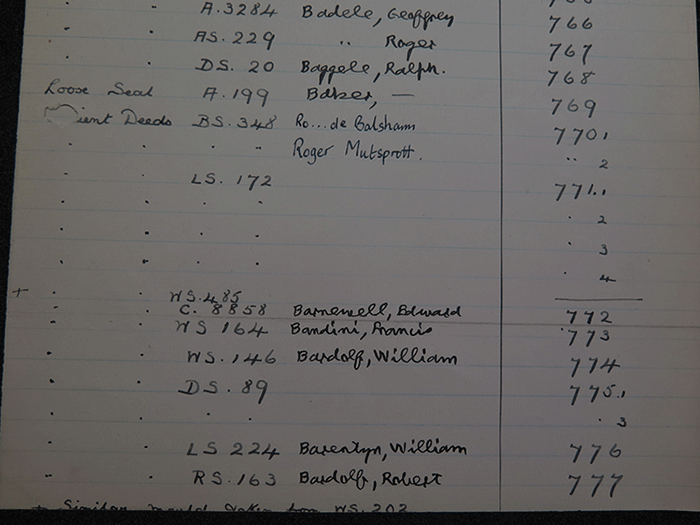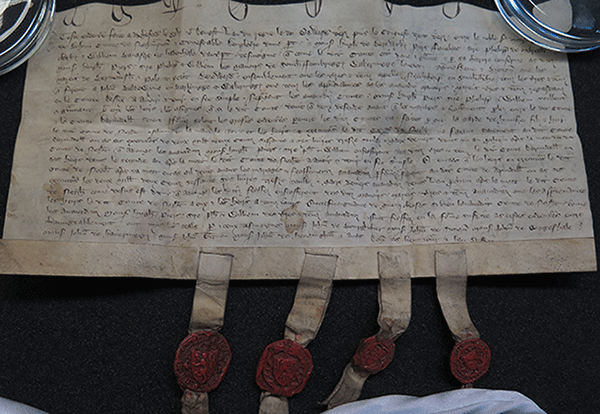We hold an historic collection of moulds taken from our wax seals. Containing some 7,700 items, the collection is the largest of its type in the UK. But why do we have them? Who made them, and what are they for?
These were the questions posed – and answered from technical and material perspectives – by Amy Sampson in her blog last November introducing the project to digitise the seals moulds in our PRO 23 series.
In this post I want to show how we have helped to improve access to this important collection, and to ask what digitisation of the moulds might mean for researchers.
The project involves image and metadata capture, editing and processing by a team of volunteers, to make ready for uploading to Discovery (our online catalogue). Much of the information about the seals from which the moulds were cast comes from a variety of sources that require different skills and knowledge to interpret.
Descriptive notes compiled by Roger Ellis, Assistant Keeper and seals studies expert at the Public Record Office (PRO)[ref]R H Ellis (ed.), ‘Catalogue of Seals in the Public Record Office: Personal Seals’, two volumes (London: HMSO, 1978–81); R H Ellis (ed.), ‘Catalogue of Seals in the Public Record Office: Monastic Seals’ (London: HMSO, 1986). For a general overview of seals in the British Isles, see: P D A Harvey and A McGuinness, ‘A Guide to British Medieval Seals’ (London: British Library and Public Record Office, 1996).[/ref], harvest information from his own research and from the PRO’s seals card index. The index contains detailed descriptions for over 30,000 seals and is now available digitally as series QFA 1. Relevant cards bear an ‘M’ to show a mould number corresponding to each seal that has been cast.

Notes created by Roger Ellis to document the wax seals moulds collection at The National Archives (unaccessioned records held by the Collection Care department)
These notes, together with others compiled during the moulding process and published calendars of deeds – those written transactions by which land and property were transferred and authenticated with a wax seal[ref]Documents were rarely signed during much of the Middle Ages: M T Clanchy, ‘From Memory to Written Record, England 1066–1307’ (2nd edition: London, 1993), passim.[/ref] bearing a legend (lettering around the circumference) and a design (or ‘device’) identifying the owner – form the basis of the digital database from which new catalogue descriptions are generated.
Such descriptions include:
- a broad category of the seal type
- the name of the seal owner(s), both individuals and corporate bodies
- the colour and dimensions of the seal
- the reference of the parent document, from which researchers can link through to that document to order a copy or to be produced in the Map and Large Document Reading Room at The National Archives.
Inevitably, though, as scanning progresses and data is checked, queries arise, quite often about nothing more than the identity of a seal owner for a surviving mould. Amy and her team of volunteers have become expert in using and interpreting a range of reference material. Notably, this includes the indispensable six-volume ‘Catalogue of Ancient Deeds’ (and the unpublished typescript lists only available on site), the three-volume set ‘Heads of Religious Houses’ to identify abbots, abbesses, priors, prioresses, and masters of Templar or Hospitaller houses, or the ‘Handbook of British Chronology’ to identify leading churchmen or government officials.[ref]’A Descriptive Catalogue of Ancient Deeds’ preserved in the Public Record Office, six volumes (London: HMSO, 1890–1915); ‘The Heads of Religious Houses: England and Wales’, 940–1540, ed. D Knowles, C N L Brooke, V C M London and D M Smith, three volumes (Cambridge, 2001, 2008); ‘Handbook of British Chronology’, ed. E B Fryde, D E Greenway, S Porter and I Roy (third edition, London: Royal Historical Society, 1986).[/ref]
But these resources are occasionally insufficient to tease out missing information, and palaeography skills are needed to read and interpret the original records. This is often the case where multiple moulds for seals attached to a document have been taken, but not every seal has a description or there is an historic identification query against it. This is where I come in.
The best way to attempt to resolve a query is to examine the original document. As a rule, seals should be examined in the context of their relationship with the parent document and vice versa. Each can tell you things the other cannot. Property deeds are usually written – as they are today – in a series of set phrases where the variations are mainly the names of the parties, property, amounts to be paid in rent or for purchase, or the names of those individuals who witnessed and thus authenticated the transaction.
Quite often the opening address clause, translated (usually) from Latin and which names the parties (‘Know that we Persons A, B and C have given, granted and by this our present charter have confirmed to Person X…’), gives the best clue with which to identify a seal owner. Otherwise we can check the sealing clause. This comes towards the end of the deed and is often explicit about the seal owner(s) and, importantly, those instances where the seal of another individual or institution whose identity and status is better-known in a particular locality substitutes for, or sits alongside the seal of, a grantor.
The sealing clause often reads something like, ‘In testimony of which thing, we have affixed our seal to this our present charter’. Where a substitute is used, it might say something like, ‘In testimony of which thing, and because my seal is not well-known in these parts, the seal of the mayor and community of the city of X is appended in order to better confirm this our present charter’. In these cases, an examination of the actual seal can confirm what the document tells us. However, this is by no means an infallible system, as substitute seals are used silently on many occasions. There are also many cases where the document is vague and not immediately helpful.
The other option is to examine the seal itself. The lettering that identifies the owner – the legend – sometimes survives in good enough condition to match up with the text despite degradation of the wax due to the brittle nature of the material. Certainty is often not possible, though, for reasons of damage: we leave a description as ‘unidentified’ in the hope that researchers can help us to complete descriptions in future rather than plump for something potentially misleading.

Indenture between William de Bohun, Earl of Northampton, and Sir Hugh de Berewyk, Piers Fauelore, Sir Phillip de Melreth, clerk, and William Banastre, by which the earl grants them the manors of South Fambridge, Wakering and others in Essex, 26 August 1359. (DL; 27/172. Duchy of Lancaster copyright material in The National Archives is reproduced by permission of the Chancellor and Council of the Duchy of Lancaster)
The document above is a fairly routine example: an agreement for the transfer of several manors and lands in Essex in 1359 between William de Bohun, Earl of Northampton, Sir Hugh de Berewyk, Piers Fauelore, Sir Phillip de Melreth, clerk, and William Banastre of Hadenhale. Ellis’ notes give us little information except that we have four moulds, numbered 771 to 774. Previous research had identified the first and last seals (looking left to right) as belonging to Berewyk and Banastre, but Amy was unclear about the others.
On examining the document, the opening clause explains that this document is an indenture. This is a legal instrument for conveying land and property, where the text is written one way up and sealed by the four recipients to be kept by the earl, and the exact same text is copied the other way up and sealed by the earl for the recipients to keep as proof of the transaction. It is then cut in half with a wavy line so that, when challenged, either party could produce their half, and if the two halves matched both had an authentic copy. Both the opening clause and the sealing clause clearly name the outstanding individuals.
Close up on the names of Sir Hugh de Berewyk, Piers Fauelore and Sir Phillip de Melreth, clerk. (DL 27/172. Duchy of Lancaster copyright material in The National Archives is reproduced by permission of the Chancellor and Council of the Duchy of Lancaster)
In this case, a closer look at the seals themselves suggested that Fauelore and Melreth were the parties. In fact confirmation was found in The National Archive’s seal card index. This revealed other examples of the seals of both men where the description of the heraldry (for Melreth of a Catherine Wheel inside a shield, and of a chevron between three lions rampant for Fauelore) exactly matched what we have appended.

Close up of the seals of Sir Hugh de Berewyk, Piers Fauelore, Sir Phillip de Melreth, clerk, and William Banastre of Hadenhale, 1359. (DL 27/172. Duchy of Lancaster copyright material in The National Archives is reproduced by permission of the Chancellor and Council of the Duchy of Lancaster)
A major step forward
What does this all mean for researchers? The digitisation project is a major step forward in various ways. Online images with searchable metadata have opened up The National Archives’ seal collection as never before. Catalogue descriptions for many sealed documents do not necessarily contain the detail that a seal is attached, and often have little descriptive data about that seal. Researchers can now access new data about those seals from which a mould was cast. They can also match a mould – and therefore a seal description – to an original document from the catalogue more easily.
Moreover, as the seal moulds are linked to the historic card index, this now becomes more readily searchable. Although the seals card index is not a complete list of seal moulds, at the very least it will point the way to seals in the collection or to individuals and communities for which seals survive. The capacity to download high-quality scans of surviving moulds also provides a bank of artistic depictions of individuals, their dress or armour, animals and plant life, mythical beasts and buildings that bring to life the richness of the pre-modern world.
Finally, as Amy emphasised in her introductory blog, seal moulds have an intrinsic value in cases where the cast original no longer survives, or where it has been damaged since casting and where less of the image and/or legend can be interpreted. Hopefully this will serve to improve our knowledge of these miniature masterpieces, which embodied so much of a person or a community’s legal and cultural identity from the Middle Ages onwards.
If you would like to find out more about this exciting project, please register for the study day by the Guild of One-Name Studies ‘Medieval and More’, to be held at The National Archives on Saturday 16 February.
I am inquiring regarding contracting wax collector seals on the verso of a Dutch Old Master painting bearing two different seals. How does one contact an expert in this field?